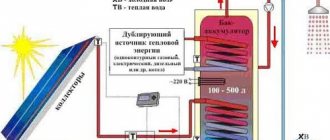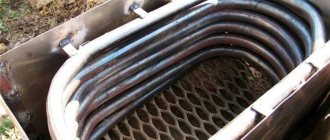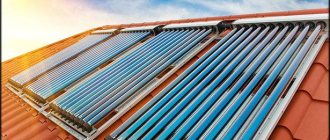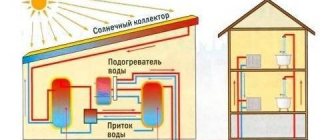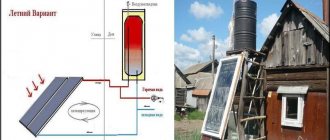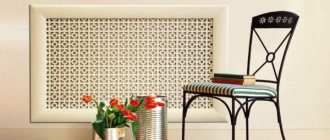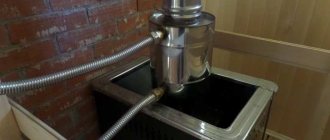How solar collectors work
A solar collector is a functional structure used to generate energy. Its photosensitive elements absorb light to heat the liquid or air inside the tubes.
The principle of operation of a solar collector (SC): the rays of the sun heat the black plates, and the energy is accumulated for domestic needs. The method of obtaining it is environmentally friendly and economical.
The following types of household collectors are distinguished:
- flat;
- vacuum;
- air.
Let's talk more about each of these types below.
Flat
Popular and budget-priced devices. They consist of a flat photosensitive plate connected to heat-conducting pipes, a glass coating, thermal insulation and a metal frame. The plate absorbs sunlight and accumulates thermal energy, which heats the coolant fluid. Unlike other types, they lose a lot of absorbed heat. Ineffective in cloudy weather. High humidity has a bad effect on structural parts.
Vacuum
There are 2 types of vacuum collectors: direct-flow and with indirect heat transfer. The former are used in the warm season, the latter - all seasons. The design is based on a vacuum tube system with a metal rod inside, which contains a coolant fluid. This installation works on the principle of a thermos. Characterized by optimal efficiency.
Air
The principle of operation is similar to flat ones. But air collectors use air as a coolant. Installed for heating houses. Heated air fills the room using air ducts and a fan.
The type of device is chosen based on the purpose of use. The designs are suitable for summer cottages, cottages, village houses and duplexes.
The operating principle of modern solar systems
The concept of “solar collectors” combines several design options for home use, but the operating scheme is not fundamentally different. All collectors “powered” by the Sun are equipped with a system of tubes, which, depending on the design of the equipment, can be mounted in the form of a coil or connected in series to the output and input lines. The coolant fluid for solar systems—water, oil or antifreeze—circulates in the tubes themselves. The absorption and subsequent accumulation of thermal energy from the Sun is carried out by absorbers. In technical terms, the design is quite simple. The high cost of such installations is due to the use of expensive materials.
For the outer surface of the structure, wear-resistant materials with excellent light transmission characteristics are used - organic glass, polymer compounds and others. But since polymer “synthetics” cannot withstand prolonged exposure to UV rays (they have a high coefficient of thermal expansion, which leads to depressurization of the solar system), manufacturers use tempered or organic glass as an alternative. And the tubes themselves are most often made of borosilicate glass, which is characterized by a minimal coefficient of thermal expansion (8 times less than quartz glass). That is why the material does not crack during sudden temperature fluctuations.
Where to install solar collectors
The main condition for the operation of the collector is an open space where direct sunlight freely reaches at any time of the year. The device is installed in the territories of private houses, where there is no shadow from other buildings and trees. More often, photosensitive plates are mounted on the roof of a building.
A common method is to install several plates, so-called “geofields”. Both pitched and flat roofs are suitable for installation. Due to the large weight of the collector, it is fixed to supporting structures - beams, rafters, etc.
The devices are installed on balconies or horizontal surfaces of the facade. To make it work more efficiently, photosensitive elements in Russia are located strictly on the south side. If they deviate to the west or east, the absorption coefficient of solar rays will decrease.
Payback period for a solar system
A simple calculation will help you understand how quickly expensive solar collectors pay for themselves. For example, it will be a flat device with an area of 2 “squares” with a daily output of 6.4 kWh of heat.
When the main source of thermal energy is an electric boiler, the kilowatt-hour it produces will cost 5 rubles (according to 2022 prices), which means that the daily savings on power supply when operating a flat device will be 6.4x5 = 32 rubles, and the payback period at the price of the device is 20 thousand – 625 days (20000:32=625).
When the main heat source is a gas unit, a kilowatt-hour of energy will cost 0.7 rubles, and the daily savings will be 6.4 x 0.7 = 4.48 rubles. The payback period will increase to 4464 days or 12 years. If we take into account that the average life of a collector is no more than 15 years, we can conclude that in this case the solar system will never pay off.
How to calculate collector area
The working surface area of the system is calculated taking into account its type and location features. It should be remembered that the efficiency of the collector depends on the temperature conditions and the amount of solar energy.
Approximate values for summer in Russia per 1 m²: up to 160 kWh per month, the rest of the time - from 20 to 80 kWh.
For hot water supply you will need approximately 100 * 1.16 * 30 = 3.48 kWh. At the same time, 1.16 Wh is the energy that will be needed to heat 1 kg of water by 1 °C.
Heat pumps are used to regulate energy production in hot weather. Also in summer, structures are covered with a thick awning if they generate a lot of energy. The installation plan and area of photosensitive elements are determined individually.
Classification by temperature regime
Solar equipment for the home is often classified by type of coolant. Today, liquid and air systems can be found on the world market. In addition, collectors are divided according to operating temperature conditions, that is, classification is applied according to the maximum heating temperature of the working elements. The following types of systems are distinguished:
- low-temperature - the coolant for solar collectors heats up to 50℃;
- medium temperature - the temperature of the circulating liquid does not exceed 80℃;
- high-temperature - the maximum temperature of the coolant material can rise to 300 degrees.
The first two options are most suitable for home use, while collector models with high-temperature operating conditions are more often used in the manufacturing and industrial sectors of the economy. This is due to the fact that in high-temperature water heating systems the process of transforming solar energy into heat is quite complex. Moreover, such solar installations occupy large areas. Not every owner of a “dacha” property can afford such luxury.
What should be the angle of inclination of the collector?
The installation angle of the flat solar collector depends on the following factors:
- Region of residence. For the southern regions - 30-35°, for the middle zone - from 40°.
- The time of year when the installation is planned to be used (summer or winter season, year-round). For all-season use, choose an angle that is approximately equal to the geographic latitude of the region. In summer this value is reduced by 15°. In winter, on the contrary, they increase.
- Climatic conditions and precipitation. If the solar system is used in winter, the angle of inclination is made steep so that snow does not accumulate on its surface.
In the accompanying instructions, the manufacturer indicates the optimal angle of inclination for each solar heater. Compliance with all conditions for determining angular inclination values contributes to the most efficient operation of the equipment.
A little about the use of systems in practice
I decided to add this section because actual usage data appeared. A good friend of mine installed it 3 years ago (Ukraine, Kiev region).
A solar system is used to heat a house of 100 sq. m and hot water for 6 people. Gas costs for heating and hot water amounted to 33,400 UAH
in year. It was decided to purchase a solar collector.
The kit includes 6 flat collectors and a storage tank of 1000 liters. Result:
- — 100%
for 6 “warm” months according to the DHW load (temperature 55 degrees), - — 50%
during 6 “cold” months according to the DHW load, - — 25%
for 6 “cold” months based on heating load in maintenance mode.
The total savings for the year amounted to UAH 11,300
(in terms of rubles, the amount must be multiplied by 2.2).
The whole system cost 94,000 UAH
. At this cost of gas, it will pay for itself in 8.4 years. Manufacturers provide a 15-year guarantee, so at least 7 years of net profit.
The efficiency of the system could be significantly increased by purchasing vacuum models. Also, low temperature heating systems, such as heated floors, which operate at a temperature of 30-40 degrees, will be more efficient.
Necessary tools and materials for installing a solar collector
Installation of solar collectors is carried out outdoors. Consequently, the structure itself, the pipeline system and all auxiliary fastenings are subject to environmental damage over time. They may experience corrosion and deformation. Therefore, only stainless materials are used for installation.
To install the solar collector, use the following auxiliary tools:
- crane or lift;
- scaffolding;
- roof ladder;
- safety equipment - vest, rope, etc.;
- building level;
- vacuum grip;
- insulating material for pipes.
The reliability, efficiency and durability of the equipment depend on the quality of installation.
Making devices yourself
You can arrange hot water supply and heating using solar collectors made by yourself. Their simplest design will consist of a polyethylene pipe for water supply, laid in the shape of a spiral, which is placed in a wooden frame and covered with a polyethylene film.
But such a homemade collector has disadvantages:
- low efficiency due to the fact that the heat exchanger does not have contact over the entire area of the substrate, as a result of which a lot of heat is wasted uselessly;
- energy dependence;
- insufficient protection from wind and mechanical damage.
If you want to assemble a device that will last a long time and provide heating for your home using solar collectors in winter, you can use the step-by-step instructions:
- The channels for the heated liquid are welded to the lower and upper manifold. To do this, it is advisable to use profile pipe products having a size of 20 x 20 millimeters - due to their flat edge, they are able to provide thermal contact with the absorber substrate. Nozzles with 1/2-3/4 inch threads are welded to the manifolds, designed to drain liquid.
- A backing made of 3mm steel sheet is attached to the tubes by welding. The gap between tacks should not exceed 20 centimeters. This distance allows you to avoid deflection of the sheet and avoid breaking contact with the tubes.
- A wooden frame is built around the absorber. Between the absorber sheet and the edges of the frame, gaps are left necessary for installing glass and laying insulating material. The wood must be pre-treated with an antiseptic.
- Holes are drilled in the frame for pipes that remove coolant.
- The absorber is insulated with mineral wool from the back side. Then the thermal insulation material is covered with boards, sheets of plywood or OSB.
- Next, the absorber is painted with black silicone heat-resistant paint, since conventional paint compositions for external use begin to peel off under these operating conditions. The edges of the frame are then glued with a rubber window seal and covered with ordinary 4 mm glass. If the glazing is formed from several sheets, then you need to seal the joints using silicone sealant.
- The glass is pressed to the frame using an aluminum or galvanized corner, having previously glued its front side with a window seal.
Solar collector connection diagrams
When installing a solar water heater or heating system, a storage tank must be connected to the device. It is needed due to the disproportionate energy consumption and distribution of generated heat. Over time, the tank fills with water, which the system owners use at their discretion.
It is recommended to install a standard boiler or buffer tank. A rationally constructed design is a connection of a collector with a heat conductor, which communicates with the boiler.
For home heating
In the northeastern regions of Russia, there is no maximum solar activity in autumn and winter. Solar power plants are used as an auxiliary energy source for heating. The connection diagram is shown in the figure below.
The solar collector is connected to the water supply and a circulation pump. The energy is used to indirectly heat the room.
For hot water supply
There are 2 options for use: for summer and winter.
The first one is suitable for summer residents. They heat water only in summer. Therefore, such an installation has minimal inertia. It is necessary to install the solar collector below the level of the storage tank so that the water circulates naturally.
In winter, antifreeze is used as a coolant fluid, which is poured into a storage tank with a coil. Due to its continuous circulation, the water is constantly heated to the optimal temperature.
Heating + hot water
The essence of the connection diagram is the combination of heating and domestic hot water processes. A double-circuit heat-storing tank with an internal reservoir is used. This helps separate process water from drinking water. For automation, an SC controller is included in the circuit to prevent overconsumption.
For heating the pool
To warm up a portable or stationary pool, use a submersible pump. It can be replaced with an automated pumping station, which will circulate cold water from the pool, and heated water from the SC.
Purpose
Solar collectors are designed to capture energy from the sun. The principle of their operation is quite simple. It lies in the fact that the incoming radiation heats the coolant. Looking at the photos of solar collectors, you can see that they all have an external similarity. They consist of panels with tubes that heat up when exposed to the sun.
The resulting heat can be used to heat water for household needs or for heating premises. The heated coolant enters the storage tank. An additional heater can be installed in it, which increases the temperature of the coolant to the required value when the intensity of solar radiation is insufficient.
Heating can be done using an electric heater or using a more advanced heat pump. In addition, this device can transfer heat to the heating system, supplementing it in order to save money.
The use of collectors allows you to either completely abandon heating devices or significantly reduce their use and provide additional savings in electricity or gas.
Installation and cost of connecting a solar collector by specialists
Installing solar collectors is a labor-intensive task. If you have experience in such work, you can do the installation yourself.
Before installation, it is recommended to study the instructions and read information on specialized forums. Installation of the popular IC “Soltek” and Solar Fox can be viewed in a special video instruction.
Installation of the solar collector and its connection to the water supply can be ordered from certified companies. The installation price depends on the region, the minimum amount is 12,000 rubles. The estimate includes external and internal work.
The use of collectors for partial or full heating and hot water supply is a rational solution. This is an environmentally friendly and affordable way to generate energy that will help you save on utility bills.
Features that you should pay attention to when choosing a collector
The rate of transfer of radiant solar energy from the sun into thermal energy of the coolant in a vacuum solar collector directly depends on the size of the tubes of this device. If the vacuum tube of the collector is short and thin, then it will not be able to accumulate vacuum energy effectively enough. Typically, tubes up to 2 meters long with a diameter of about 6 centimeters are used to complete vacuum solar collectors. A simple straight or curved U-shaped tube can be mounted inside the vacuum tube for more efficient heat collection.
Heating with solar air system
Installation of air heating is done in a similar way, only the heat exchanger is made of pipes of larger diameter, and the discharge is provided by a fan. Craftsmen make radiation receivers from the following materials:
- aluminum corrugation for ventilation;
- plastic bottles inserted one inside the other;
- beer cans with the bottom cut out.
The box has 2 holes for air pipes; a fine mesh is laid inside to prevent insects from entering. The fan - a computer cooler - is installed on one of the holes, the heat exchange part is painted black. The supply pipes are insulated and laid in a heated room. The air manifold assembly algorithm is shown in the video:
Cons of the system
- Dependence of operating efficiency on the installation angle
. It is better to position the collector at right angles to the sun's rays, so it is advisable to orient it to the south. If such an installation is not possible, if the house has already been built, do not tilt the structure more than 45° to the east or west. Place it at an angle of 30–45°. In addition, the collector should not be subject to shadows from neighboring buildings or tall trees.
Recommendation! It is advisable to consider the location of the solar collector at the design stage. This will allow you to effectively orient the collector and provide in advance for reinforcement of the roof racks and places for the outlet of the pipes connecting to it.
- Difficulty in installation
. The rigidity of fastening the structure to the house must be sufficient to withstand gusts of wind. When installing the collector, the roof should not leak due to leaky connections.
High-quality thermal insulation of the places where pipes enter the house will prevent them from freezing in these places. But at the same time, the insulation must be well covered - large birds, for example, crows, peck at it.
- Impossibility of use as the only source of heating. In the autumn-winter period, when the heating in the house is turned on, the days are short, and there are many more cloudy days than sunny days.
Experts divide household solar collectors into flat and vacuum Source remstrdom.ru
See also: Catalog of companies that specialize in heating.

